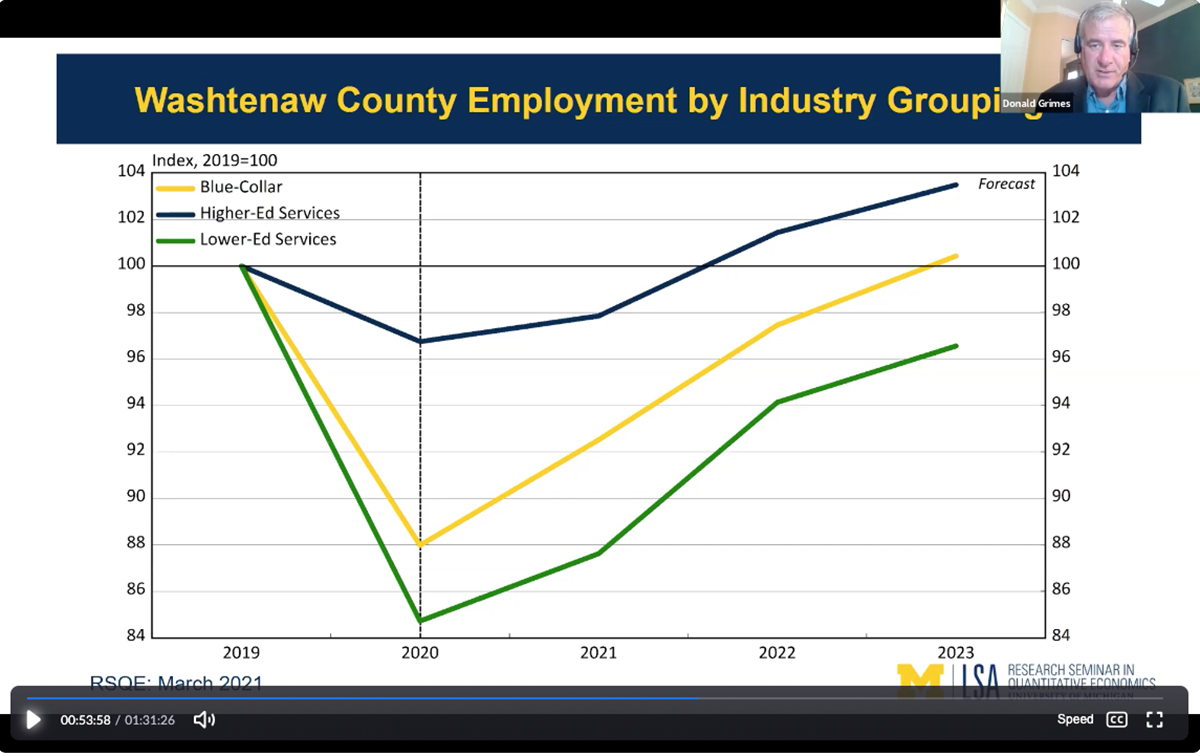
While Washtenaw County, as a whole, is expected to fully recover from the economic impact of the COVID-19 pandemic by 2023, low-income wage earners without some post-secondary education will continue to feel the effects.
While presenting the 36th annual Economic Outlook for Washtenaw County report to the Washtenaw Economic Club on Thursday, March 25, University of Michigan economists Donald Grimes and Gabriel Ehrlich noted there was already a problem with the distribution of prosperity across Washtenaw County before the pandemic hit in March 2020.
“I think that disparity in 2023, if our forecast is accurate, will actually be worse when we finally get that data because the job growth is not going to come through nearly as strongly for people with less education,” said Grimes.
Grimes noted that Washtenaw Community College – which has operated the Washtenaw Economic Club since 2010 – is the county’s best hope to minimize those trends.
“Your role in the community, in terms of trying to alleviate some of these disparity issues, cannot be overstated,” Grimes said to WCC President Dr. Rose B. Bellanca, who was part of the virtual presentation of the report. “And so I wish you a lot of luck. You’ve got a challenging, important job ahead of you.”
The overall outlook for the county is a positive one in terms of recovering from the current recession, the economists noted. Just as Washtenaw County was not as severely impacted by job loss and small business closures as other areas across the state of Michigan, it is also expected to continue to recover at a faster rate.
(The full report and presentation slides can be downloaded from the Washtenaw Economic Club website.)
All of the forecasts made in the report, Ehrlich noted, hinge on the continuation of current trends as related to the pandemic.
“COVID-19 remains in the driver's seat of the economic recovery, but according to current data, the trend is still pretty encouraging here in Washtenaw County,” Ehrlich said. “We're certainly not epidemiologists, but the situation as we see it, and I think this is a pretty commonly held view, is that we're really in a race right now between new variants of COVID-19 and the rollout of vaccines against the disease.”
Grimes reported that the unemployment rates in both Michigan and Washtenaw County are expected to return to the same levels they were at in 2019 by the end of the report’s forecast in 2023. He added that more jobs will be added to the Washtenaw County economy (19,056) by 2023 than were lost (16,207) at the onset of the pandemic.
Most of the industries expected to best recover are those with above-average wages, Grimes noted, while those not expected to make a full recovery by 2023 are low-wage jobs. Therein lies the concern for greater economic disparity across the area.
The report divided the Washtenaw County economy into three major industry groups: higher education attainment service industries (people with a bachelor’s degree), blue collar industries (manufacturing, construction, transportation, warehousing) and lower education attainment service industries.
Grimes noted that those in the lower education category already receive half as much pay as the blue collar or higher education groups, and that disparity will grow slightly over the next three years.
During the 2020 recession, the number of jobs in higher education industries declined by about 3%, the number of jobs in the blue collar industries declined by 12% and the number of jobs in the lower education industries by 15%.
Grimes called that “an incredibly unusual situation.” He said in a typical recession, lower education industries have the fewest job losses. “So 2020 was extraordinarily unusual.”
Things don’t get much better in the future for the low education jobs category, which will remain 3% below 2019 levels by the end of the 2023 forecast. On the other hand, the number of jobs in the higher education category exceeds 2019 levels by 4% by 2023 and blue collar jobs are expected to return to 2019 levels.
Grimes said the industry that will suffer more in terms of wage growth and job growth is the lower education category, “which means that the job opportunities for people with less education in Washtenaw County, and elsewhere in the state, is really a problem.”
One potential solution, Grimes noted, is the retraining of workers who were emplyed in industries that are not expected to recover to fill some of the anticipated job growth in the quickly growing construction and warehousing industries.
While thanking Grimes and Ehrlich for participating in the event, Bellanca noted that the new Michigan Reconnect scholarship for those 25-and-older without a college education would be helpful in helping Washtenaw County avoid the economic disparity the economists fear.
---
The Washtenaw Economic Club would like to thank event sponsors Ann Arbor SPARK, Washtenaw County and Washtenaw Community College for their support.
The Washtenaw Economic Club's next event will be "The Future of Mobility" on May 11. It wil feature State of Michigan Chief Mobility Officer Trevor Pawl, Automative Relations Director at AutoTrader.com Michelle Krebs and Direcor of the WCC Advanced Transportation Center Al Lecz. See more information.
Tags: April 2021, Economic Outlook, On The Record, Washtenaw Economic Club, Workforce Training, ousearch_News_2021
